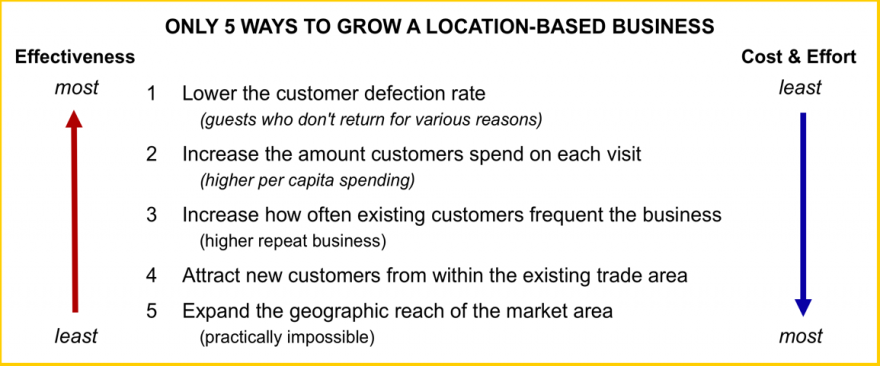
Vol. XXII, No. 4, April 2022
There are only five ways to grow a location-based business
There are only five ways for any location-based entertainment, retail, restaurant, or leisure facility to grow its business. Unfortunately, most businesses concentrate (and make the most significant investment of money and management energy) on the ways that offer the lowest return. What most miss are ways to grow their businesses with the customers they already have, the way that gives the greatest return on investment and effort.

The most effective way to grow any business, based mostly on return on effort and cost, is to stop defections or customers who don't return - also known as the leaky bucket. Customers don't return for numerous reasons, but most of those reasons involve things a business can control. Most businesses spend lots of money trying to attract new customers, while the existing ones just leak away.
The five ways to grow a business, revenues, and profits, in increasing degree of effort and cost and decreasing effectiveness, are:

The first three, which focus on existing customers and their experiences when they visit, are the easiest to accomplish and give the highest return on expended effort and investment. The last two are focused on attracting new guests and generate a much lower return, if any at all, especially in terms of developing loyal repeat customers.
Unfortunately, most businesses mistakenly focus on the last two, assuming they are the best way to grow. They fail to concentrate on the first three, and most importantly, the first, customers who defect, who leak out the bottom of the bucket. Those businesses are constantly chasing after new customers while existing customers are walking out the door and never returning.
Our company has analyzed many existing location-based entertainment businesses (LBEs) for clients who wanted to improve sales and profitability. Consistently, we have found customer defection rates (also called churn rate) of 25% and higher, meaning 25% to half of existing guests abandon the LBE each year. Just to stay even, these businesses must advertise, market, and run promotions to recruit large numbers of new customers to replace the ones they've chased away, the ones who will never come back (and probably tell their friends not to, as well!). It's like pouring water into a leaky bucket, as new guests simply replace old ones who've taken their time and money elsewhere.
There are many reasons why customers defect. It can be because of a bad customer service encounter with an employee, dirty restrooms, broken equipment, poor quality or cold food, excessive noise, unappealing ambiance, uncomfortable furniture, and hundreds of other possibilities.
The pandemic has impacted many customers' choices for their out-of-home leisure experiences. Rather than merely memorable experiences, many are now looking for highly meaningful ones, which raises the bar to attract and keep them. This includes highly social, face-to-face ones after their periods of social isolation and restriction, such as ones that competitive socialization venues offer (see article) and transformative experiences. In fact, in today's world, with so many leisure options competing for customers' limited disposable leisure time, including all the at-home digital options, it can be as simple as not offering a compelling enough experience to make guests want to return.
A survey based on interviews with 90,000 North American retail consumers by the Toronto-based Verde Group in association with the Jay H. Baker Retailing Initiative at Wharton School found that about 45% of customers who experience problems never contact the company. "Organizations that assume no news is good news are at significant risk," according to the report. "Rather than complain, these people spread negative word-of-mouth and then vote with their feet by making future purchases elsewhere."
A survey by thinkJar found that about two-thirds of customers (67%) defect because of service or quality problems that could be fixed with relative ease. Customers believe complaining will do no good, feel that it is not worth the time, do not know where or how to complain, or fear hostility or retribution.
An American Express survey found that one-third of Americans (33%) say they'll consider switching companies after just a single instance of poor service. PWC found that 32% of people said that after just one negative experience, new and current customers would stop doing business with a brand or company they'd previously loved despite previously excellent customer service.
And if that isn't convincing enough about the cost of customer defections, a survey by loyalty marketing firm Maritz found that more than two-thirds of American consumers (68%) reported they had in the past two years defected or considered defecting from a company they had frequently used. Of those who left a company, 43% cited service experiences as their main reason. Of those who left, 83% said they had told others about their negative experience.
Reasons cited for defecting were:
- Poor customers service systems or policies (85%)
- The poor attitude of an employee (77%)
- An employee's low level of knowledge about how to help (76%)
- An employee's lack of decision-making authority or empowerment to help (72%)
Focusing on retaining existing guests is known as managing for zero defections. By retaining existing customers, you increase sales by generating more revenue from them over a longer time. Studies have shown that even a 5% decrease in defections can result in a 25% or greater increase in profits.
The second and third easiest ways to grow a business, which are both equally effective, also focus on existing customers: keep them at the facility longer and offer them more options, so they spend more money and visit more frequently. If customers are spending more and coming more often, that means they must be happy with your business. High quality, craveable food, and drink can be very effective in achieving this. Limited-time offerings (LTOs) can also generate more frequent visits (check out our article The lure of LTOs). Continually adding more attractions doesn't necessarily work to increase time visiting or spending, as often new attractions will only cannibalize use and revenues from existing ones.
By focusing on the first three ways to grow a business - on existing customers- you do a better job of attracting new customers than the traditional route of advertising and discounting. Reducing customer defections and keeping customers happy will usually take care of attracting new customers. Customers who are delighted with your business will not only want to return, but they will also become your business disciples, telling their friends through positive word-of-mouth marketing to become your customers.
Powerful? You bet! Think about how you choose restaurants to visit. Would you be more likely to visit one with an eye-catching ad in the newspaper or one that a friend praised to the skies? Yeah, we thought so. And just in case you still aren't sure how powerful positive word-of-mouth from happy customers can be, one online study conducted by Boston-based research firm Chadwick Martin Bailey found that 27% of the U.S. population had eaten at restaurants based solely on the recommendations of friends, neighbors, or relatives. In addition, 47% of respondents to the survey said they had recommended full-service, casual-dining restaurants to others during the past year.
Focusing and investing in current customers rather than those you don't have creates the greatest profit. Yes, it's different from the conventional wisdom that advertising and marketing are the way to go. An enormous amount of research shows that investing in the quality and consistency of the experiences your existing customers have is your best avenue to growth and success.


